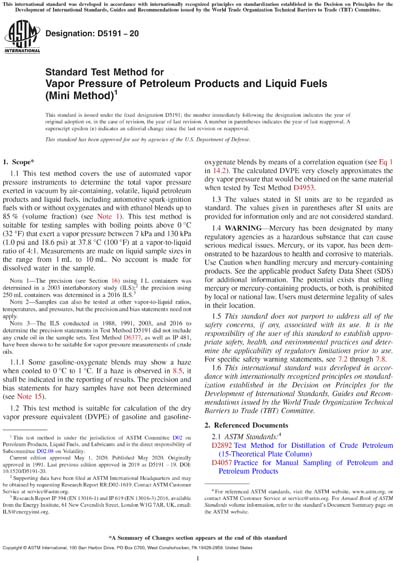Historical
ASTM D5191-20
Standard Test Method for Vapor Pressure of Petroleum Products and Liquid Fuels (Mini Method)
1.1 This test method covers the use of automated vapor pressure instruments to determine the total vapor pressure exerted in vacuum by air-containing, volatile, liquid petroleum products and liquid fuels, including automotive spark-ignition fuels with or without oxygenates and with ethanol blends up to 85 % (volume fraction) (see Note 1). This test method is suitable for testing samples with boiling points above 0 °C (32 °F) that exert a vapor pressure between 7 kPa and 130 kPa (1.0 psi and 18.6 psi) at 37.8 °C (100 °F) at a vapor-to-liquid ratio of 4:1. Measurements are made on liquid sample sizes in the range from 1 mL to 10 mL. No account is made for dissolved water in the sample.
Note 1: The precision (see Section 16) using 1 L containers was determined in a 2003 interlaboratory study (ILS);2 the precision using 250 mL containers was determined in a 2016 ILS.3
Note 2: Samples can also be tested at other vapor-to-liquid ratios, temperatures, and pressures, but the precision and bias statements need not apply.
Note 3: The ILS conducted in 1988, 1991, 2003, and 2016 to determine the precision statements in Test Method D5191 did not include any crude oil in the sample sets. Test Method D6377, as well as IP 481, have been shown to be suitable for vapor pressure measurements of crude oils.
1.1.1 Some gasoline-oxygenate blends may show a haze when cooled to 0 °C to 1 °C. If a haze is observed in 8.5, it shall be indicated in the reporting of results. The precision and bias statements for hazy samples have not been determined (see Note 15).
1.2 This test method is suitable for calculation of the dry vapor pressure equivalent (DVPE) of gasoline and gasoline-oxygenate blends by means of a correlation equation (see Eq 1 in 14.2). The calculated DVPE very closely approximates the dry vapor pressure that would be obtained on the same material when tested by Test Method D4953.
1.3 The values stated in SI units are to be regarded as standard. The values given in parentheses after SI units are provided for information only and are not considered standard.
1.4 WARNING—Mercury has been designated by many regulatory agencies as a hazardous substance that can cause serious medical issues. Mercury, or its vapor, has been demonstrated to be hazardous to health and corrosive to materials. Use Caution when handling mercury and mercury-containing products. See the applicable product Safety Data Sheet (SDS) for additional information. The potential exists that selling mercury or mercury-containing products, or both, is prohibited by local or national law. Users must determine legality of sales in their location.
1.5 This standard does not purport to address all of the safety concerns, if any, associated with its use. It is the responsibility of the user of this standard to establish appropriate safety, health, and environmental practices and determine the applicability of regulatory limitations prior to use. For specific safety warning statements, see 7.2 through 7.8.
1.6 This international standard was developed in accordance with internationally recognized principles on standardization established in the Decision on Principles for the Development of International Standards, Guides and Recommendations issued by the World Trade Organization Technical Barriers to Trade (TBT) Committee.
Content Provider
ASTM International [astm]






